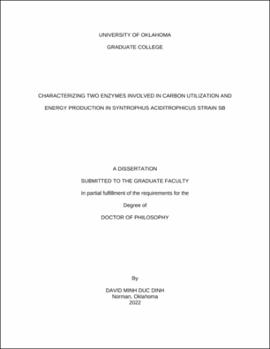| dc.description.abstract | Methane is both an alternative energy source and a potent greenhouse gas. Biomethanation relies on the metabolic syntrophy between fermenting bacteria, syntrophs, and methanogenic archaea – where large organic molecules are metabolized to methane in a microbial assembly line. In most cases, the metabolism of syntrophs is the rate-limiting step – so when their metabolism is hindered, methanogenesis is also hindered. In this dissertation, two enzymes from the metabolic pathway of Syntrophus aciditrophicus strain SB, a model syntroph, are investigated to understand how the organism efficiently utilizes carbon and produces energy. Previous studies have found that S. aciditrophicus strain SB utilizes a novel mechanism to produce ATP with an AMP-forming acetyl-CoA synthetase (SaAcs1). In other organisms, Acs-family enzymes typically function in the AMP-forming direction rather than the ATP-forming direction. S. aciditrophicus strain SB maintains high intracellular levels of AMP and PPi, which makes ATP production by SaAcs1 favorable. The objective of this dissertation was to further investigate SaAcs1 on a structural level using X-ray crystallography and expand on previous functional studies by incorporating site-directed mutagenesis to explore the role of key amino acids in SaAcs1 activity. The structure of SaAcs1 bound to acetyl-AMP in the adenylation conformation was resolved at 3.24 Å resolution. Several structural differences were observed when compared to other previously described Acs-family proteins. Specifically, lysine 619 in the ATP/acetyl-AMP/AMP-binding site protrudes further into the substrate pocket when compared to other Acs structures. Additionally, in other Acs-family structures, there are two highly conserved charged amino acid residues at the entrance of the CoA tunnel where the overall positions of these residues do not change regardless of the presence of CoA or the conformation of the enzyme. Whereas in SaAcs1, the position of these residues (arginine 191 and 194) is shifted. These structural differences may contribute to the operation of SaAcs1 in the ATP-forming direction in S. aciditrophicus – especially when combined with the higher intracellular concentration of pyrophosphate and AMP. Alanine substitutions at key residues that may interact with ATP, acetyl-AMP, and AMP (Ser273, Gly395, Thr420, Trp421, Trp422, and Arg536) were introduced into cloned Sa acs1 using site-directed mutagenesis. Substitutions at Ser273 and Arg536 resulted in no acetyl-CoA-forming activity, and substitutions at Gly395, Thr420, and Trp421 resulted in lowered acetyl-CoA-forming activities. As for the acetate-forming activity, alanine substitution at Ser273 resulted in no activity whereas substitutions at Gly395, Thr420, Trp421, and Arg536 resulted in lowered activities when compared to wildtype SaAcs1. The lowered acetyl-CoA- and acetate-forming activities of all variants suggest that these residues may play an important part in the enzymatic reactions of SaAcs1. The structural and enzymatic findings of SaAcs1 provide greater insight into how S. aciditrophicus strain SB persists given the constrained thermodynamics. Furthermore, the structure of SaAcs1 in the adenylation conformation is a contribution to the study of the Acs protein family. There are just a few Acs structures in the adenylation conformation in the Protein Data Bank. Medically-relevant microbes often use Acs enzymes in their fatty acid synthesis – therefore, Acs enzymes have been prime targets for therapeutics so additional knowledge of this family of proteins has the potential to aid in therapeutic design. Previous studies have found that the degradation and formation of benzoate and cyclohexane-1-carboxylate in S. aciditrophicus strain SB share the same suite of enzymes. Both benzoate and cyclohexane-1-carboxylate have been shown to be converted by BamR, BamQ, and BamA to 3-hydroxypimelyl-CoA. From there, 3-hydroxypimeloyl-CoA dehydrogenase (SaHcd1) has been proposed to convert 3-hydroxypimelyl-CoA to 3-oxopimeyl-CoA. In this dissertation, the structure of a putative SaHcd1 was determined to 2.30 Å and contained six β-sheets, eight α-helices, and three unresolved loops. Further investigation of the enzymatic activity is needed to confirm that the heterologously expressed enzyme is capable of the specific substrate conversion, converting 3-hydroxypimelyl-CoA to 3-oxopimeyl-CoA and vice versa. A previous genomic study does show that the gene of the putative SaHcd1 is expressed at high levels in S. aciditrophicus strain SB, providing further evidence that this enzyme is expressed and used in the pathway. Overall, the structure of SaHcd1 provides more information into the enzymes that participate in the syntrophic conversion of fatty and aromatic acids into the precursors for methanogenic metabolism. Overall, the primary objective of this dissertation is to provide additional information on how S. aciditrophicus strain SB generates ATP and metabolizes carbon sources. Although the application of anaerobic digestion for production is not a novel application and various research has been conducted on metabolic syntrophy in anaerobic environments, there are still unknowns in syntrophic metabolism and energy conservation. This dissertation focuses on two parts of a complex biological system: two enzymes from a model syntrophic organism that is part of the microbial conversion of natural polymers to methane. Producing methane through anaerobic digestion to serve as an alternative to fossil fuels and managing methane emissions are important long-term goals. Therefore, to be successful in the application of anaerobic digestion, a better understanding of syntrophic metabolism is crucial to the larger picture and goal. | en_US |
